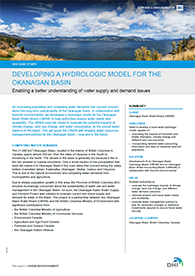Helping to assess the supply and demand for the Okanagan Basin’s water
We developed a hydrologic model for the 21,600 km2 Okanagan Basin Water Board (OBWB) – in collaboration with Summit Environmental – to help authorities assess water needs and availability.
 We developed a hydrologic model for the 21,600 km2 Okanagan Basin Water Board (OBWB) – in collaboration with Summit Environmental – to help authorities assess water needs and availability.
We developed a hydrologic model for the 21,600 km2 Okanagan Basin Water Board (OBWB) – in collaboration with Summit Environmental – to help authorities assess water needs and availability.
An increasing population and competing water demands has caused concern about the long-term sustainability of the Okanagan Basin (British Columbia, Canada). To address this, the Okanagan Basin Water Supply and Demand Project was initiated to evaluate current and future supply and demand for water in the Basin.
As part of the project, the OBWB conducted a Surface Water Hydrology and Hydrologic Modelling Study. We prepared the hydrologic model that represented the historical hydrologic conditions and responses of the entire basin using data on:
- gridded climatic data
- spatially-distributed land-use data
- spatially- and temporally-distributed vegetation data
- spatially-distributed soils data
- groundwater aquifer characteristics
- detailed river networks
We used the hydrologic model to calibrate a MIKE 11 hydraulic model of the five mainstem lakes in the basin. This including calibrating the model to historical dam operations and lake levels throughout the 11-year calibration period. The calibrated model was then used as a predictive tool to estimate the individual and combined impacts of:
- population growth
- water efficiency policies
- climate change
- deforestation due to mountain pine beetle infestation and clear cutting
The final results of the model were made available through the Okanagan Water Database, a central repository of water data for the basin. The results of future modelling scenarios will be used by the OBWB to help shape water resources management policies for the Okanagan Basin. In addition, these results will be made available via a web portal as a public communication tool to support the policy development process.
Read more